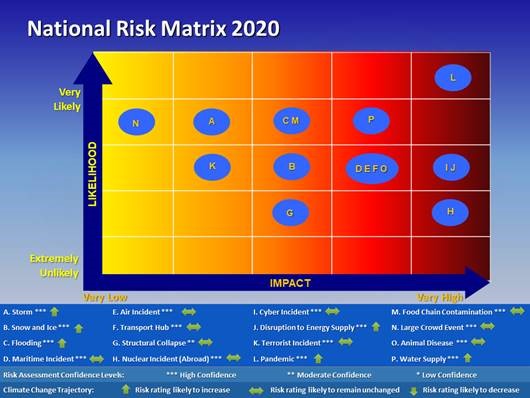A-National-Risk-Assessment-for-Ireland-2020
Minister for Defence Simon Coveney, T.D., as Chair of the Government Task Force on Emergency Planning, has published the National Risk Assessment for Ireland. It has been developed by the Department of Defence’s Office of Emergency Planning in conjunction with Dublin City University and the members of the Government Task Force on Emergency Planning.
The National Risk Assessment was noted by Government earlier this week. When briefing Government, the Minister emphasised that
the National Risk Assessment has been developed following extensive consultations with all Departments and key Agencies and the input of subject matter experts.It identifies and assesses the likelihood and impact of key risks facing the State across a broad range of emergencies.
This National Risk Assessment provides a basis for establishing priorities for the mitigation of the key risks identified at national level and will inform Government decisions regarding resource allocation.
The Minister added
It is intended that publication of this document will enhance public awareness of the significant risks which the State faces and which are being addressed by colleagues across Government.
This National Risk Assessment has also been shared this week with the European Commission as part of Ireland’s national commitments under the EU Civil Protection Mechanism and will form part of the EU-wide risk assessment process.
The National Risk Assessment for Ireland 2020 will be published at www.defence.ie and
www.emergencyplanning.ie
[ENDS]
Briefing Notes for Editors:
The National Risk Matrix 2020 (Extracted from the National Risk Assessment):

The National Risk Assessment for Ireland 2020 – Background
The White Paper on Defence (2015) sets out the Government's commitment to maintain, and further develop, a robust strategic emergency management framework nationally. A White Paper on Defence Update 2019 was published in December 2019, which included an updated security environment assessment. This update noted that perceptions of real as well as possible or assumed risks combine to create the overall picture. Capturing this very complex picture will always be challenging given that there will always be a degree of subjectivity involved and there will always be unknown future risks. This is taken into account in the production of this National Risk Assessment.
The purpose of the National Risk Assessment is to identify the key risks facing the State across a broad range of emergencies, to assess the likelihood and impact of these risks and to inform actions at a national level aimed at mitigating such risks. It provides a basis for establishing priorities with regard to risk mitigation at national level and to inform Government decisions regarding resource allocation. It replaces the National Risk Assessment for Ireland 2017.
Compared to the previous assessment produced in 2017, this new National Risk Assessment includes four new areas of consideration proposed by the EU: low probability high impact risks; a climate change trajectory, cross-border risks and emerging risks. In addition, a Household Emergency Preparedness Survey conducted by Dublin City University was included for the first time. This public participation helped enhance the communication of the National Risk Assessment process, increasing risk awareness across the nation
Strategic Emergency Management National Structures and Framework Background
The Strategic Emergency Management National Structures and Framework and the associated Annexes was approved by Government on 26 July 2017. It identifies 50 different emergency/incident types across a range of Lead Government Departments. It provides the basis for the National-level strategic emergency management and the supports required should such emergencies occur where a national-level response is warranted. Emergencies should be dealt with locally wherever possible. The Major Emergency Management Framework prepared by the Department of Housing, Planning, Community and Local Government guides the local and regional responses and inputs into the National-level responses.
The Government Task Force on Emergency Planning, which is chaired by the Minister for Defence, includes senior representatives from all Government Departments and Agencies. It is responsible for the oversight and coordination of national-level emergency management. Responsibility for the response to an actual emergency remains with the Lead Government Department identified in Annex A of the Strategic Emergency Management National Structures and Framework.